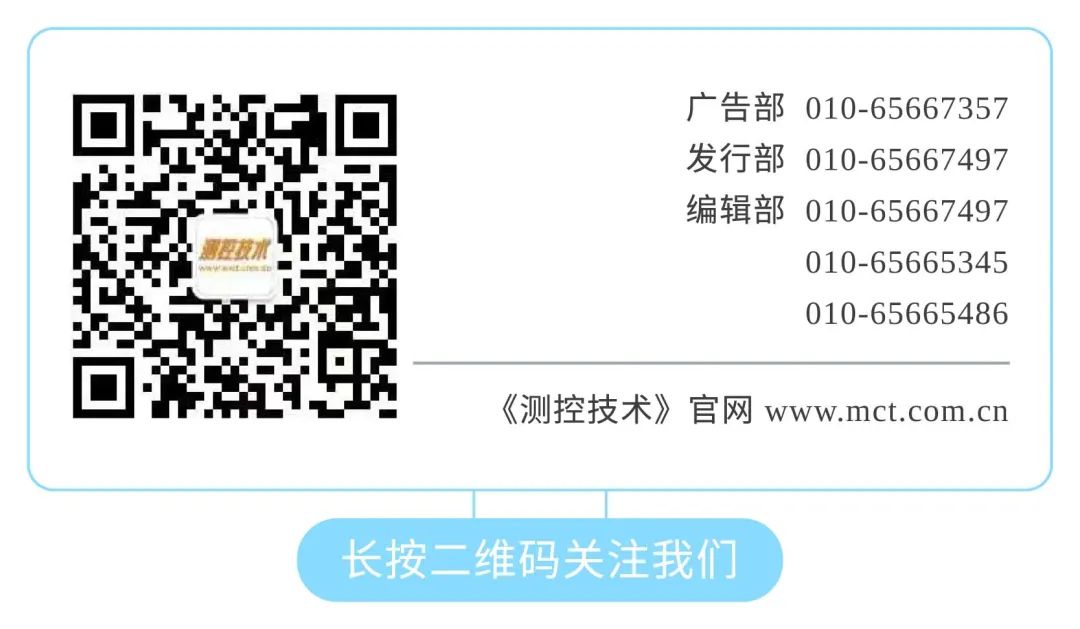Wireless sensor networks are a novel technology for information acquisition and processing, integrating the logical information world with the physical world. Wireless sensor networks show broad application prospects in an increasing number of fields.
Cloud computing is a flexible method for organizing and providing IT resources. It supports distributed storage and parallel processing, with its data processing framework handling most data locally without the need for extensive remote data transmission.
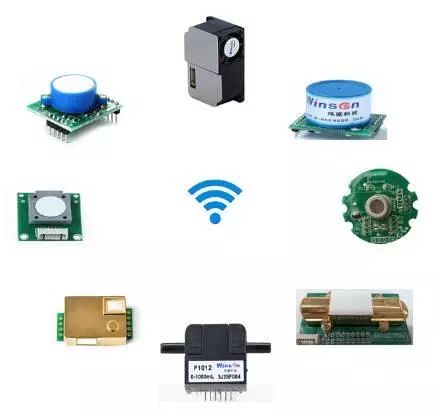
Cloud Sensors
Cloud sensors integrate measurement perception, network transmission, and cloud components. Their feature is to combine sensing components and networking components, allowing the data collected by sensors to be directly uploaded to the cloud platform, where users can access the data directly, saving the cost of intermediate transmission processing circuits.
Advantage 1: Simple to use; users can read the sensor measurement data directly via computer or mobile phone after powering on;
Advantage 2: Cloud computing enables real-time networking of cloud sensors, allowing the cloud platform to perform big data processing using real-time sensor data, with the results of big data processing also fed back to the cloud sensors. The most direct application is to achieve online dynamic calibration of sensors, using big data to eliminate local measurement errors;
Advantage 3: Facilitates rapid secondary development for customers, avoiding complex cloud construction and saving costs.
Cloud Computing Based Wireless Sensor Networks
1. Architecture
The architecture of cloud computing-based wireless sensor networks is illustrated in the figure. A set of special nodes distributed in the wireless sensor network (WSN) area is called cloud nodes. Cloud nodes have richer resources than sensors and serve two functions. On one hand, these nodes form the cloud and are part of the cloud; on the other hand, they can communicate with sensors to collect data from attached sensors, also known as aggregation points (point sink). Sensors send perceived data to a specific aggregation point (in a multi-hop manner), and the aggregation point stores the data in the cloud. Sensors sending data to the same aggregation point form a group; to differentiate from the cluster concept in WSN, this group is called a partition (zone). For sensors, the entire cloud appears as a virtual aggregation node (virtual sink).
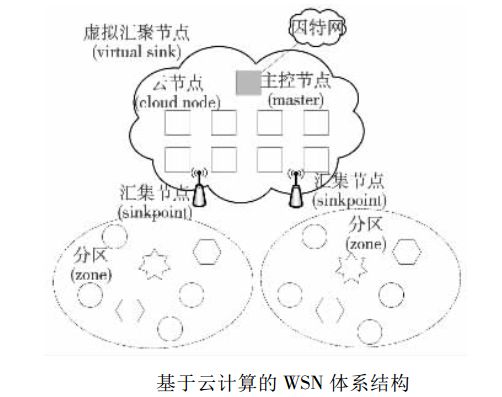
2. Partition Sensor Organization
Sensors are assigned to a partition based on certain rules. For example, sensors can join the partition represented by the nearest aggregation point. Sensors within each partition can be of the same or different types, forming a local wireless sensor network independent of other partitions. All local wireless sensor networks connect to form a whole through the cloud. Sensors in a partition can be organized in a flat structure or hierarchical structure.
In a multi-layer WMSN structure, the same type of sensors is organized at the same level, forming a WSN; the lower-level WSN connects to the upper level through central nodes, with the upper-level central nodes forwarding data for the lower level. At the same time, the upper-level central nodes can also process the forwarded data, scheduling the activities of sensors at this level, such as sleep or activation. This working mode reduces sensor energy consumption compared to keeping sensors always activated. However, it makes the design and maintenance of sensor software more complex. Additionally, the central nodes need to handle and forward a large amount of data, which will accelerate energy consumption.
In the cloud-based architecture, another organization method for partitioned sensors is illustrated in the figure. Sensors of the same type each form a WSN and send their data to the aggregation point (if same type sensors cannot communicate directly, different type sensors can serve as gateways). Each type of sensor constitutes a logically independent but physically overlapping WSN, and these WSNs connect to the same aggregation point. Data processing software is deployed in the cloud (not just at the aggregation points connected to these WSNs). After collecting and processing various perceived data, the cloud can (through the aggregation points) schedule sensors in each independent WSN to operate in a reasonable manner. Compared to the cluster-based single-layer structure, this organizational method achieves smaller independent WSNs within partitions, higher transmission efficiency, and control information still has a global network perspective.
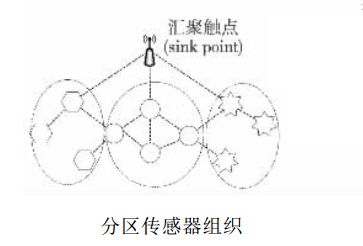
3. Cloud Organization
When cloud nodes form the cloud, the following issues need to be considered: a) How to deploy cloud nodes in the WSN area; b) How cloud nodes communicate with each other; c) How nodes are organized into the cloud; d) How the data collected by the aggregation points is stored in the cloud and processed in the cloud.
The selection of cloud node (aggregation point) locations depends on the distribution of sensors in the wireless sensor network. Ideally, the aggregation point locations can minimize data transmission operations throughout the network, and complex algorithms can be used for location selection. However, due to the dynamic characteristics of WSN (topology changes, routing changes, diverse data generation locations and patterns, etc.), achieving the ideal goal is difficult. In cases where sensors are evenly distributed, a simple method is to have each aggregation point responsible for collecting data from approximately equal numbers of sensors.
Cloud nodes must communicate with each other to form the cloud. Cloud nodes need to be reasonably deployed in the WSN area, operating in a manageable environment, and thus there may be network infrastructure. If a wired network exists, nodes can use methods such as VPN for secure communication; if there is a mobile communication network (such as 2.5G, 3G, LTE, etc.), cloud nodes can also interconnect using these networks. However, wireless sensor networks are typically deployed in infrastructure-free environments, and self-organizing wireless networks are the only available communication method. For example, cloud nodes can be configured with the IEEE 802.11 protocol stack to form an Ad hoc network.
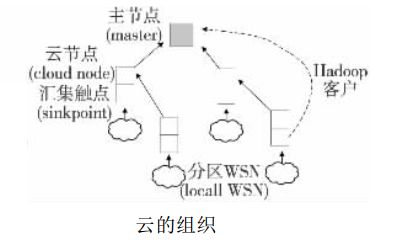
Uploading Sensor Data to the Cloud
Wireless standards have undergone tremendous changes, allowing sensors to synchronize large amounts of data to the cloud and retrieve it whenever needed. People have recognized the potential benefits of the Internet of Things. We will see a variety of solutions, but in the end, only those that are more useful and cost-effective will survive.
Through wireless connections, we can access cloud space on multiple devices. Below are several ways to synchronize sensor data to the cloud.
1. Wired Connection

This is the simplest method, originating in the 1970s and 1980s, and is the ancestor of all wireless connection methods. A microprocessor is equipped in the sensor to process the collected data, which is then uploaded through a wired network. Additionally, this processor can modify or update certain functions of the sensor. However, this method has significant limitations, as it is impossible to have wired connections everywhere.
2. Mobile Network Connection
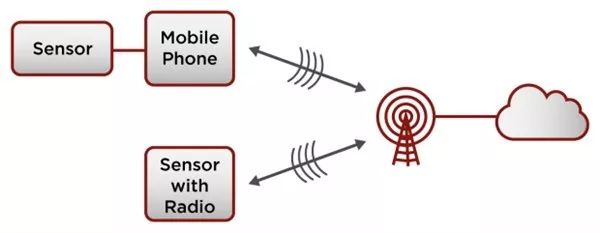
The mobile network followed the wired network’s inception and developed in the early 1980s. This network naturally became the first widely used wireless network. However, it also has many drawbacks: first, to connect to a mobile base station, sensors still need to connect to the phone via a wired connection or embed a dedicated baseband in the phone (which is costly); second, the uplink wireless transmitter requires significant power support; finally, data charges can be quite burdensome.
3. Remote Wireless Network Connection
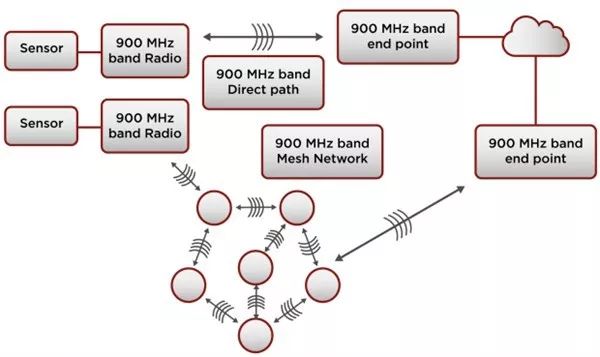
As early as 1947, regulators opened many unlicensed wireless frequency bands, but at that time, these were largely ignored until the emergence of mobile phones in the 1990s, when people began to recognize their value. In 2003, the 902-928 MHz and 2400-2483 MHz bands became popular for the latest IEEE 802.15.4 wireless standard.
The mesh networks mentioned earlier also use these bands, consisting of many small low-power wireless devices that are highly interconnected, gathering sensor data from edge areas to a collection point, all of which are connected to the cloud. This ensures the coverage of the wireless network.
4. Connection via Wireless Router
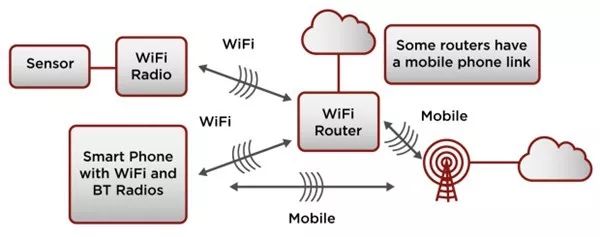
The well-known 802.11 Wi-Fi standard emerged in 1997, using the 2400-2483 MHz and 5130-5835 MHz frequency bands. These two bands have profoundly impacted everyday wireless life, with such routers being ubiquitous in homes, companies, and public places.
Additionally, there are some specialized routers primarily used in industrial and infrastructure fields. As long as a wired connection is made, the router can connect to the cloud; in fact, wireless routers are the main channel for people to enjoy cloud services in everyday life.
With the emergence of Wi-Fi functionality on smartphones, sensors capable of directly connecting to routers have also emerged. This means that as long as they are within the router’s signal coverage, sensors can connect to the internet anytime, eliminating the complex process of connecting to mobile base stations.
5. Connection via Mobile Phone
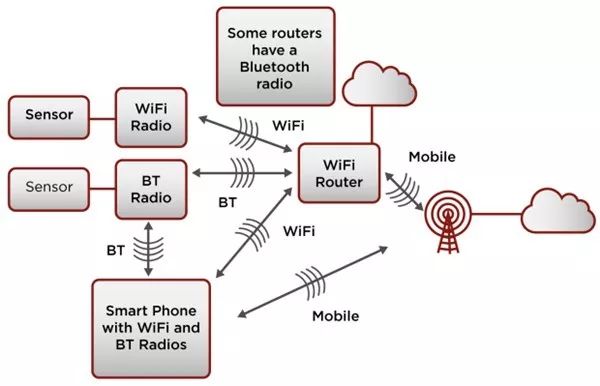
In real life, there are many instances where sensors do not need to connect to a wireless router; a mobile phone can handle everything. This way, users can directly interact with the sensors to obtain the information they need. Moreover, in many application scenarios, there is no need for long-distance data transmission; wireless earphones are one such example.
These data transmissions can be completed via Bluetooth, which works in the same frequency band (2400-2483 MHz) as Wi-Fi. This standard was established in 1998, and in 2003 it became part of the 802.15.4 standard, yet it continues to play its role today.
Recently, technicians introduced a new low-power Bluetooth technology (BLE), which is energy-efficient and suitable for low-rate or low-duty-cycle simple sensors. This technology provides strong momentum for the development of small sensors, which previously required wireless networks or mobile networks (such as various smart wristbands) to interact directly with mobile phones.
Recently, technicians have also added Bluetooth functionality to traditional Wi-Fi routers. This allows sensors equipped with BLE technology to connect directly to the cloud through the router, eliminating the need to connect to a mobile phone.
With the continuous growth of various wireless standards, we can use more methods to promote the development of the Internet of Things.
With the development of the Internet of Things, sensor networks integrate cloud computing technology, elevating the data processing technology of sensors to a new level, significantly increasing the information obtained, and further integrating various functions, which is an inevitable trend of development, and this will indirectly promote the development of sensor technology.
Source: Sensor Technology
END
Hot Articles (Scroll Up to Read)
Paper Recommendation | Zhong Zeyu:Design and Implementation of a Generalized Multifunction Micro-Flywheel Testing System
Paper Recommendation | Yang Huixin: Method for Predicting Solid Engine Ablation Based on DCNN and Data Augmentation
Paper Recommendation | Guo Cui: Research on Dynamic Model of Accelerometer Based on GWO-BP Method
Paper Recommendation | Ding Haofeng: Visual Guidance Method for Autonomous Landing of Drones Based on Multi-Level Cooperative Identification
Paper Recommendation | Wang Xiaofei: SVDD Online Learning Algorithm for Large-Scale Data
Paper Recommendation | Liu Heng: Design of Full-Displacement Balanced Robot Based on Fuzzy Control
Paper Recommendation | Yang Yunlong: Research on Pulse Wave Signal Preprocessing Method
Paper Recommendation | Ding Zhengdao: Research on Car Headway Time Mixed Distribution Model Based on YOLOv5+DeepSORT Detection Data
Paper Recommendation | Zhan Keyi: Research on Aerodynamic Instability Detection Pipeline Design of Aircraft Engines
Paper Recommendation | Liu Hao: Efficient Human Pose Estimation Based on Diverse Convolution Units
Paper Recommendation | Wang Hong: Application and Development of Aviation Testing Technology for Intelligent Assurance
Paper Recommendation | Zhao Xiaoping: Small Sample Gearbox Fault Diagnosis Method Based on Transfer Learning
Paper Recommendation | Zhu Xinyun: Progress in Flight Data Analysis and Application Research for PHM in Civil Aircraft
Paper Recommendation | Wan Yuhong: Research Progress of Terahertz Time-Domain Spectroscopy Technology in Coating Detection
Paper Recommendation | He Yunze: Development and Application Review of Image-Based Multimodal Perception and Multi-Source Fusion Technology
Paper Recommendation | Ou Zhengyu: Current Status and Prospects of Underground Pipeline Detection Technology
Paper Recommendation | Ren Liping: Multi-Dimensional Health Monitoring Data Feature Selection
Paper Recommendation | Chai Yongsheng: Experimental Research on Strength Monitoring Technology of Glass Fiber Reinforced Plastics Based on Infrared Spectroscopy Analysis
Paper Recommendation | Liu Zenghua: Research Progress on Defect Detection of Electromagnetic Ultrasonic Horizontal Shear Waves
Paper Recommendation | Yu Haoyan: Overview of Microwave Non-Destructive Testing Technology for Non-Metallic Pipelines
Paper Recommendation | Huang Songling: Overview of Non-Destructive Testing and Online Monitoring Technology for Defects in Aircraft Engine Blades
Paper Recommendation | Xiong Pengwen: Robot Interaction Object Classification Based on Novel Multimodal Tactile Sensors
2022 Collection of Excellent Papers in Computer and Automation Technology
2022 Collection of Excellent Papers in Aerospace
Paper Recommendation | Liu Jia: Construction of a High-Fidelity Vision-Tactile Augmented Reality System
Paper Recommendation | Feng Lihang: Wheel-Leg Detection System for Soft Planetary Soil: II – Perception Wheel
Paper Recommendation | Feng Lihang: Wheel-Leg Detection System for Soft Planetary Soil: I – Conceptual Design
Paper Recommendation | Li Honghao: Application of Fiber Bragg Grating Force Sensors in Health Care
Paper Recommendation | Liang Qiaokang: Robot Multi-Dimensional Force Sensors
Paper Recommendation | Xu Hongning: Design and Implementation of a Face Recognition Algorithm Testing Platform Based on Hadoop and RabbitMQ
Paper Recommendation | Pan Kuangming: Reliability Analysis and Testing of New Type 24-Pulse TRU Based on Pulse Multiplication
Paper Recommendation | An Xin: Robust License Plate Recognition Method Based on Deformable Convolution and Adaptive 2D Position Encoding
Paper Recommendation | Qi Jinping: Overview and Prospects of Remaining Useful Life Prediction Methods for Small Sample Complex Systems Driven by Data
Article Recommendation | Chen Xuanwen: Research on Model-Driven Component Library for Flight Control Software Factory
Article Recommendation | Du Guanming: Position Measurement Technology of Aircraft Control System Input End Based on Vision
Article Recommendation | Ju Wenying: Numerical Study of Gas Invasion in Multiboundary Disc Cavities Downstream of Axial Flow Turbines
Article Recommendation | Cui Linwei: Research on SLAM Based on MEMS Laser Radar for Intelligent Wheelchairs
Article Recommendation | Zhang Zhen: Application of Industrial CT in the Aerospace Industry
Article Recommendation | Zhu Chen: Improved Algorithm for Loop Detection in SLAM Based on Stereo Cameras
Article Recommendation | Sun Yu: Research on the Application of New Fiber Optic Sensors in Pipeline Leakage Monitoring
Article Recommendation | Xiong Yunong: A Visual Measurement Technology Based on Target Recognition and Positioning Algorithm
Article Recommendation | Zhou Yitian: Bearing Fault Diagnosis Model Based on Feature-Extended CapsNet
Article Recommendation | Wang Hong: Embedded Online Monitoring Technology for Foreign Avionics Systems
Article Recommendation | Wang Bin: Three-Dimensional Measurement of Ice Shape Based on Line Structured Light Scanning
Article Recommendation | Jia Funian: Design and Verification of High Altitude Air Intake Device for Turbojet Engine
Article Recommendation | Yan Bo: Research on Oxygen Partial Pressure of Al2O3 High-Temperature Insulation Film Based on Dual Ion Beam Sputtering

